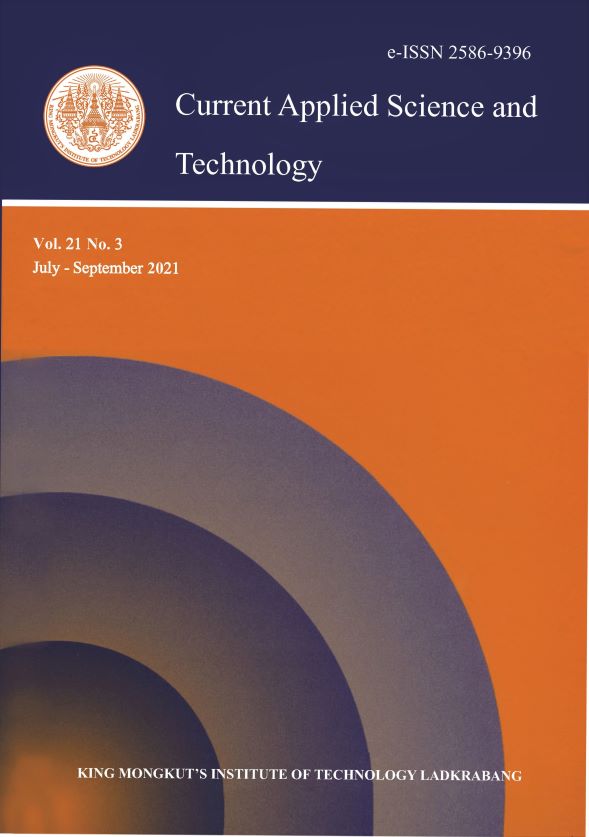Carbon Footprint of Mangosteen Farm Level Evaluation in Eastern Thailand
Main Article Content
Abstract
The study of the carbon footprint (CF) of agricultural crops provides important information that can help achieve low-carbon agriculture, but there are still very few studies on CF for farmed fruit. This research emphasized CF calculation for mangosteen crops at the farm level. The study was carried out on 55 mangosteen farms that belong to the Tambol Troknong Community Enterprise in the Khlung District of Chanthaburi Province, Thailand. The findings revealed that the product CF average was 1.71 ± 1.38 kg CO2eq/kg, and the farm CF was 15,623.41 ± 16,981.27 kg CO2eq/ha. The total CF was determined from six sources, including the application of substances such as fertilizers (organic and inorganic), pesticide and herbicide, as well as from the use of electricity and fuel. We found that most of the CF was direct emissions from electricity usage, which accounted for as much as 85.33% of the total CF. Thus, this research provides important information on the CF and level of production inputs. We developed guidelines for reducing greenhouse gas emissions from mangosteen production in the area.
Keywords: carbon footprint; life cycle assessment; greenhouse gas emission; GIS; spatial pattern
*Corresponding author: Tel.: (+66) 822313386 Fax: (+66) 38102379
E-mail: narong_p@buu.ac.th
Article Details
Copyright Transfer Statement
The copyright of this article is transferred to Current Applied Science and Technology journal with effect if and when the article is accepted for publication. The copyright transfer covers the exclusive right to reproduce and distribute the article, including reprints, translations, photographic reproductions, electronic form (offline, online) or any other reproductions of similar nature.
The author warrants that this contribution is original and that he/she has full power to make this grant. The author signs for and accepts responsibility for releasing this material on behalf of any and all co-authors.
Here is the link for download: Copyright transfer form.pdf
References
Wang, L., Li, L., Cheng, K. and Pan, G., 2019. Comprehensive evaluation of environmental footprint of regional crop production: A case study of Chizhou City, China. Ecological Economics, 164, 1-12.
Ruviaro, C.F., Gianezini, M., Brandão, F.S., Winck, C.A. and Dewes, H., 2012. Life cycle assessment in Brazilian agriculture facing worldwide trends. Journal of Cleaner Production, 28, 9-24.
Smith, P., Haberl, H., Popp, A., Erb, K., Lauk, C., Harper, R., Tubiello, F.N., Pinto, A.S., Jafari, M., Sohi, S., Masera, O., Böttcher, H., Berndes, G., Bustamante, M., Ahammad, H., Clark, H., Dong, H., Elsiddig, E.A., Mbow, C., Ravindranath, N.H., Rice, R.W., Abad, C.R., Romanovskaya, A., Sperling, F., Herrero, M., House, J.I. and Rose, S., 2013. How much land-based greenhouse gas mitigation can be achieved without compromising food security and environmental goals?. Global Change Biology, 19, 2285-2302.
Gan, Y.T., Liang, C., Chai, Q., Lemke, R.L., Campbell, C.A. and Zentner R.P., 2014. Improving farming practices reduces the carbon footprint of spring wheat production. Nature Communication, 5, 1-13.
Röös, E. and Tjärnemo, H., 2011. Challenges of carbon labelling of food products: a consumer research perspective. British Food Journal, 11, 982-996.
Alam, M.K., Bell, R.W. and Biswas, W.K., 2019. Decreasing the carbon footprint of an intensive rice-based cropping system using conservation agriculture on the Eastern Gangetic Plains. Journal of Cleaner Production, 218, 259-272.
Plaza-Bonillaa, D., Nogué-Serraa, I., Raffaillacc, D., Cantero-Martíneza, C. and Justes, E., 2018. Carbon footprint of cropping systems with grain legumes and cover crops: A case-study in SW France. Agricultural Systems, 167, 92-102.
Xu, X. and Lan, Y., 2017. Spatial and temporal patterns of carbon footprints of grain crops in China. Journal of Cleaner Production, 146, 218-227.
Zhang, D., Shen, J., Zhang, F., Li, Y. and Zhang, F., 2017. Carbon footprint of grain production in China. Scientific Reports, 7, 1-11.
Zhang, W., He, X., Zhang, Z., Gong, S., Zhang, Q., Zhang, W., Liu, D., Zou, C. and Chen, X., 2018. Carbon footprint assessment for irrigated and rainfed maize (Zea mays L.) production on the Loess Plateau of China. Biosystem Engineering, 167, 75-86.
Liu, W., Zhang, G., Wang, X., Lua, F. and Ouyang, Z., 2018. Carbon footprint of main crop production in China: Magnitude, spatial-temporal pattern and attribution. Science of the Total Environment, 645, 1296-1308.
Adewale, C., Reganold, J.P., Higgins, S., Evans, R.D. and Carpenter-Boggs, L., 2019. Agricultural carbon footprint is farm specific: Case study of two organic farms. Journal of Cleaner Production, 229, 795-805.
Knudsen, M.T., Meyer-Aurich, A., Olesen, J.E., Chirinda, N. and Hermansen, J.E., 2014. Carbon footprints of crops from organic and conventional arable crop rotations – using a life cycle assessment approach. Journal of Cleaner Production, 64, 609-618.
Regional Office of Agricultural Economics 6, 2014. Study of Greenhouse Gas Emissions of Packed Mangosteen in Troknong Green City, Chanthaburi. [online] Available at: http://oaezone.oae.go.th/assets/portals/15/ebookcategory/133_vijai_61/vijai_61/files/assets/basic-html/page1.html
Regional Office of Agricultural Economics 6, 2017. Study of Greenhouse Gas Emissions of Packed Durian and Mangosteen in Troknong Green City, Chanthaburi. [online] Available at: http://oaezone.oae.go.th/assets/portals/15/ebookcategory/133_vijai_61/vijai_61/files/assets/ basic-html/page1.html
Yan, M., Cheng, K., Luo, T., Yan, Y., Pan, G. and Rees, R.M., 2015. Carbon footprint of grain crop production in China – based on farm survey data. Journal of Cleaner Production, 104, 130-138.
Thailand Greenhouse Gas Management Organization, 2019. GHG Emission Factors. [online] Available at: http://thaicarbonlabel.tgo.or.th/admin/uploadfiles/emission/ts_f2e7bb377d.pdf
Agricultural Research Development Agency (Public Organization), 2020. Batonical Characteristics of Mangosteen. [online] Available at: https://www.arda.or.th/kasetinfo/south/ mangosteen/controller/index.php
Office of Agricultural Economics, 2019. Mangosteen: Perennial Area, Production Area, Production and Yield Per Rai in Year 2019. [online] Available at: http://www.oae.go.th/assets/ portals/1/ fileups/prcaidata/files/1mangosteen%202562.pdf


